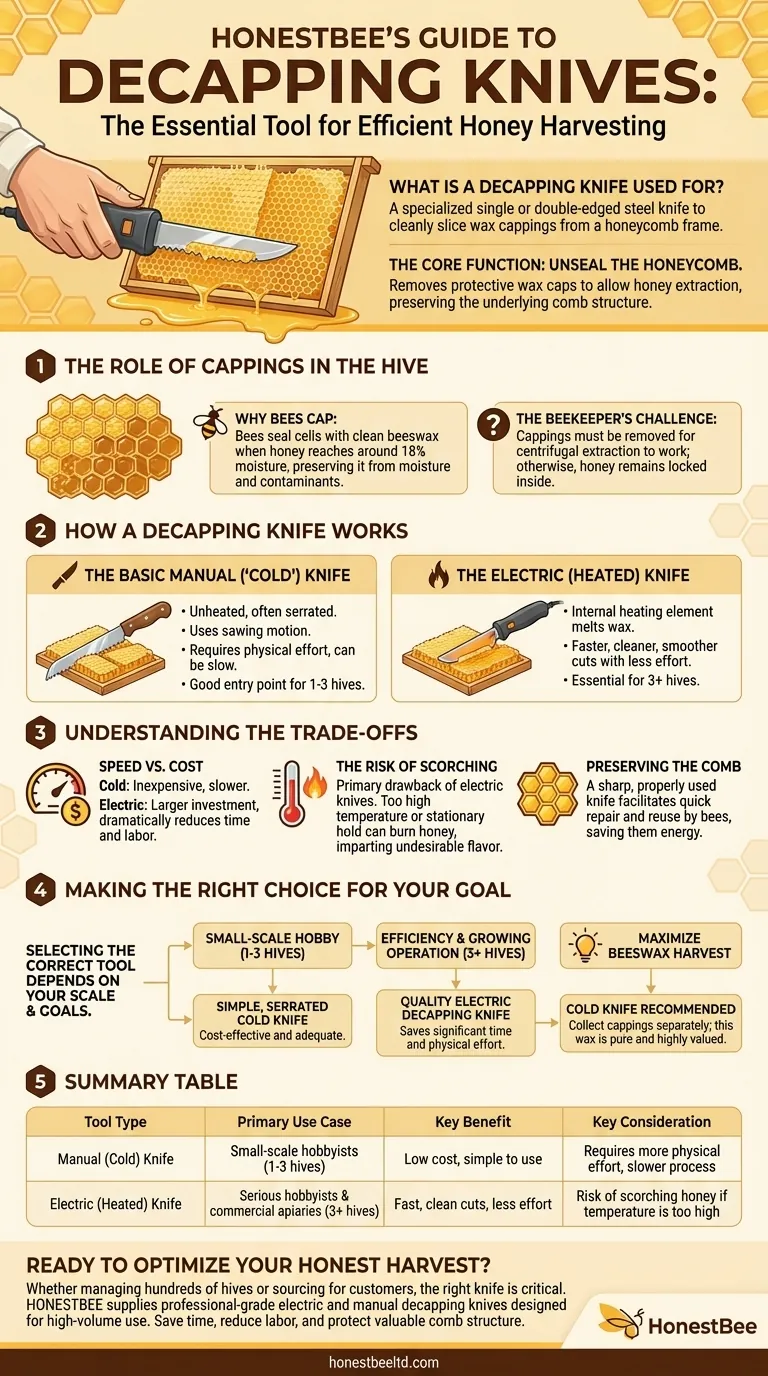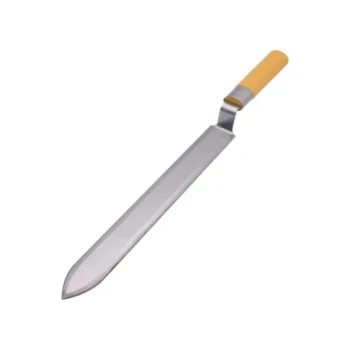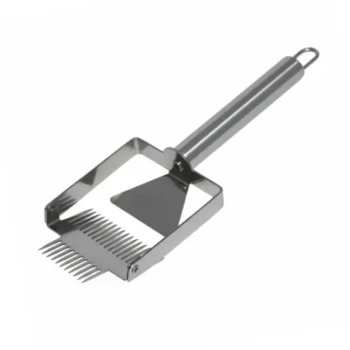In beekeeping, a decapping knife is a specialized tool with a singular, critical purpose. It is a single or double-edged steel knife used to cleanly slice the wax cappings from a honeycomb frame. This action is the essential first step in honey harvesting, as it unseals the individual cells and allows the liquid honey to be extracted.
The core function of a decapping knife is not just to cut, but to unseal the honeycomb. Without removing the protective wax caps bees place over cured honey, the honey would remain locked inside the comb during the extraction process.

The Role of Cappings in the Hive
To understand the knife, one must first understand the structure it is designed to defeat: the wax capping.
Why Bees Cap Their Honey
Bees fill each hexagonal cell in a honeycomb with nectar, which they dehydrate into honey. Once the honey reaches the correct moisture content (around 18%), the bees seal the cell with a fresh, clean layer of beeswax.
This wax capping acts as a protective lid. It preserves the honey, keeping it safe from moisture, fermentation, and contaminants until the colony needs it for food.
The Beekeeper's Challenge
For a beekeeper to harvest this honey, these protective cappings must be removed. If the frames were placed in an extractor with the cappings intact, the centrifugal force would be unable to pull the honey from the sealed cells.
How a Decapping Knife Works
A decapping knife is designed to slice off only the top layer of these wax cappings, leaving the underlying comb structure intact for the bees to reuse.
The Basic Manual ("Cold") Knife
The simplest form is an unheated, often serrated steel knife. The beekeeper uses a sawing motion to slice through the cappings. This method is effective but requires significant physical effort and can be slow.
The Electric (Heated) Knife
Most serious hobbyists and commercial beekeepers use an electric decapping knife. This tool has an internal heating element, often controlled by a thermostat.
The heat allows the blade to melt the wax as it slices. This results in a much faster, cleaner, and smoother cut with far less physical resistance, preserving the delicate comb structure more effectively.
Understanding the Trade-offs
Choosing and using a decapping knife involves balancing efficiency with potential risks. The goal is to uncap the frame quickly without damaging the comb or the honey.
Speed vs. Cost
A basic cold knife is very inexpensive, making it a good entry point for a beekeeper with only one or two hives. An electric knife is a larger investment but dramatically reduces the time and labor required for harvesting, making it essential for larger operations.
The Risk of Scorching
The primary drawback of an electric knife is the potential to scorch the honey. If the knife is set to too high a temperature or is held stationary against the comb, it can burn the honey, imparting an undesirable flavor to the final product.
Preserving the Comb
A sharp, properly used knife is crucial for comb preservation. A ragged cut from a dull or cold knife can damage the hexagonal cells. This means the bees must expend significant energy and resources to repair the comb before they can use it again. A clean cut facilitates quick repair and reuse.
Making the Right Choice for Your Goal
Selecting the correct tool depends entirely on the scale of your beekeeping operation and your primary goals during harvest.
- If your primary focus is a small-scale hobby (1-3 hives): A simple, serrated cold knife is a cost-effective and perfectly adequate tool for the job.
- If your primary focus is efficiency and a growing operation (3+ hives): Investing in a quality electric decapping knife will save significant time and physical effort during harvest.
- If your primary focus is maximizing your beeswax harvest: Collect the cappings separately in a straining bucket, as this wax is the purest in the hive and highly valued.
Choosing the correct decapping tool is the first step toward a smooth, efficient, and rewarding honey harvest.
Summary Table:
| Tool Type | Primary Use Case | Key Benefit | Key Consideration |
|---|---|---|---|
| Manual (Cold) Knife | Small-scale hobbyists (1-3 hives) | Low cost, simple to use | Requires more physical effort, slower process |
| Electric (Heated) Knife | Serious hobbyists & commercial apiaries (3+ hives) | Fast, clean cuts, less effort | Risk of scorching honey if temperature is too high |
Ready to optimize your honey harvest?
Whether you're a commercial apiary managing hundreds of hives or a beekeeping equipment distributor sourcing for your customers, the right decapping knife is critical for efficiency and comb preservation.
HONESTBEE supplies professional-grade beekeeping equipment, including durable electric and manual decapping knives, designed for high-volume use. We help you save time, reduce labor, and protect your valuable comb structure.
Contact our wholesale team today to discuss your needs and get bulk pricing on reliable harvesting tools.
Visual Guide

Related Products
- All-Stainless Steel Pivoting Honey Uncapping Fork for Beekeeping
- Stainless Steel Pivoting Honey Uncapping Fork with Plastic Handle
- Professional Honey Uncapping Roller for Efficient Harvesting
- Professional Compact Multi-Function Uncapping Knife for Beekeeping
- Professional Stainless Steel Double-Sided Honey Uncapping Knife
People Also Ask
- What is the primary use of an uncapping fork in beekeeping? A Guide to Precision Honey Harvesting
- What is the importance of choosing the right uncapping method for beginner beekeepers? Maximize Your Honey Yield & Save Time
- What are the common methods used by small-scale beekeepers to uncap honey frames?
- What is the use of an uncapping fork? A Precision Tool for Hive Management and Honey Harvesting
- What should be checked before harvesting honey from a new hive? Ensure Colony Survival First



















